
The question about the possibility of the existence of extraterrestrial life, scientists and ordinary people are asking more than a dozen years. Literally in everything, from works of art to the level of Spielberg in “E. T” and ending with the official press release the U.S. space Agency NASA, is clearly reflected how big and important this problem is for the modern man.
One of the most important sources for the existence of the life that we know is water. It is therefore not surprising that with the opening of a new exoplanet or satellite we try to find in the first place. Maybe in the end, the aliens will not look like we imagine them in a movie and quite serious scientific conferences, but their detection will become less significant for the history of mankind. And today we will talk about 10 places in the Universe where we have good chances to discover what we’ve been looking for.
TRAPPIST-1
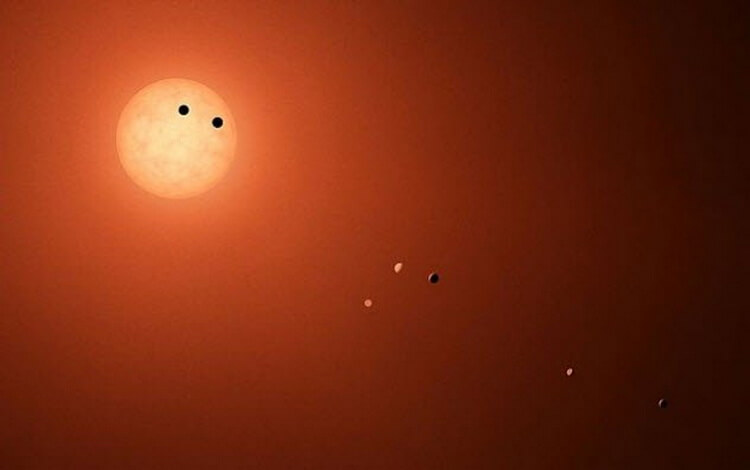
About the discovery of a planetary system, located a few tens of light years away, was announced at the beginning of this year. The system consists of 7 planets samplemodeling factors around the “ultra-cold” stars is an ideal at the moment, the goal to search for life outside our Solar system.
The study of these exoplanets in the future will be relatively simple – all because of the way they rotate around their star. Open these planets were due to transit method of observation. Using a powerful telescope, the researchers tracked when the planets passed in front of his body, partially reducing its brightness in our observational devices.
Astronomers suggest the presence of a relatively comfortable temperature on these planets, it is appropriate that on their surface could be formed in water.
And yet, despite the fact that all the planets of this system are considered as potential candidates for habitable worlds, specifically three planets TRAPPIST-1 can fit the role best, since they are in the habitable zone of a star. This region around a star where earth-like planets existing surface water could be in liquid form.
Titan

The largest moon of Saturn, the sixth planet from the Sun. This moon is considered as a potential candidate for the role of the inhabited world, but perhaps not in the sense in which we could think of. The satellite doesn’t quite fit the description of a world in the habitable zone. But it has water and other liquids. Just there’s no liquid water. The water at this planetary object is presented in the form of ice – the temperature there is very low.
However, there are liquids consist of hydrocarbons. Hydrocarbon is a chemical compound of hydrogen and carbon in various proportions. On earth, the most common types of hydrocarbon gases are methane and propane. This can be a key factor in being able to imagine life on Titan completely on the other side. It is possible that potentially there is an existing life forms will not survive under conditions of liquid water, but will quite feel comfortable in the environment of hydrocarbons.
Despite the fact that to science still have some questions (for example, about whether or not life exist not only in water), to discard the possibility of life on Titan, scientists still do not intend to.
Europe

One of the satellites of the gas giant of the Solar system, Jupiter. Another candidate for the role of the inhabited world, because there is water, which, at least according to our theories can be in a liquid state. Astronomers believe that Europe has all the necessary ingredients for life: there is water, sources of energy and the right chemical composition of the environment. Water, according to our best assumptions, hidden under the thick icy crust that forms the surface of Europa.
On the possibility of direct studies of European scientists began to speak recently. Earlier this year, it was announced that in the next few years should start the mission Europa Clipper. Within its framework, to the moons of Jupiter will be sent a spacecraft that will explore and photograph the surface of Europa. This will happen repeatedly. Scientists thus want to be able to analyze the characteristics of the satellite from all sides, and at the same time and look at the signs of life.
Mars

Our red neighbor. The fourth planet from the Sun. Perhaps one of the most discussed likely candidates for habitable worlds and potentially the first target of human colonization. Despite the skepticism, this planet is the most likely place where we will find life.
It is clear that it will not be presented in the form of little green men or any other reasonable forms. However, the space Agency NASA, exploring the surface of the planet with their Mars Rover, we found evidence that there once could, and may continue to exist at least microscopic life.
The data obtained indicate that in the past have now completely dry planet there were these streams and rivers from the water. Relying on this, we can at least assume that life on it could somehow survive. Perhaps in further research the scientists will find Mars has water in liquid form, not only in the form of ice caps at the poles of the planet.
Enceladus

Another of the many satellites of Saturn, seen by astronomers as potentially habitable world, which, unlike the hydrocarbon Titanium brother, likely rich in water. This water, as well as Europe hidden under the thick icy crust of the surface. Again, this could mean the probability of the existence at least of the microbes.
Previously, the presence of water on Enceladus was considered only as an assumption. At least this hope gave received 2015 data space probe “Cassini”. In the beginning of this year that hope is seriously increased, when the apparatus is found from the satellite of the hydrogen molecule, indicating the presence of chemical reactions going on under his surface. Presumably in these reactions ocean water of Enceladus interacts with the underlying rock, resulting in the produced energy, which could be useful for living organisms.
Kepler-186f

Kepler-186f is an exoplanet orbiting the star Kepler-186, about 500 light years from Earth. Discovered in 2014, she became the first known earth-like planets outside the Solar system with an orbit that lies within the habitable zone of its star.
It is less than 10 percent larger than the Earth, so this planet is most similar in size to our home among all detected exoplanets. Other characteristics such as density, yet remain unknown to us. But given its size, we can safely assume that it’s a rocky world.
So far, the only features that allow you to bring the planet Kepler-186f in the list of potential candidates to the inhabited worlds, are its size and location in the habitable zone of a star. About presence of water on it also it is not known, as it is unknown about what the temperature on its surface.
Kepler-452b
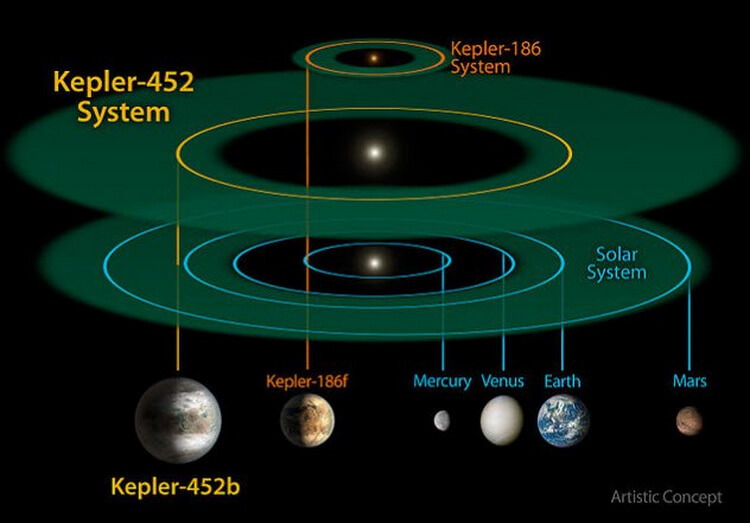
As reported by NASA itself, the planet Kepler-452b “could be one of the best targets for the search for extraterrestrial life.” However, to explore this planet will be quite difficult. At least because it is situated at a distance of over 1000 light years from Earth. But despite this, scientists are almost certain that Kepler-452b lies within the habitable zone of their stars, like several other exoplanets in this system.
Some time Kepler-452b considered by astronomers as the planet closest in size to Earth. Later this honor departed Kepler-186f. However, the star system where Kepler-452b, more similar to our Sun. Probably why Kepler-452b is now one of the objects of study of the SETI Institute, which searches for extraterrestrial life.
LHS 1140b
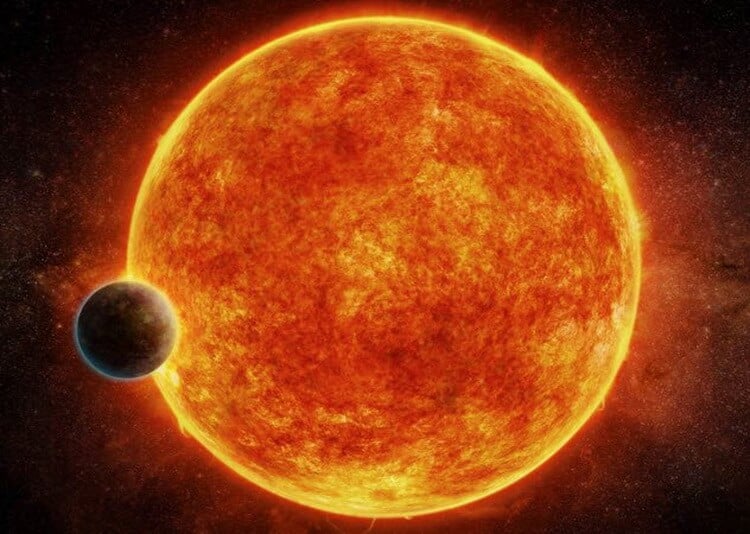
I opened this “super-Earth” recently. Scientists have found that it is in the habitable zone of a star and consider her as one of the most likely candidates for the discovery of extraterrestrial life.
This super-Earth is about 10 times more massive than our home. Astronomers believe that a class of planets that are related to super-earths, rocky planets are presented, but acknowledge that without accurate observations is not yet possible. Even so, the LHS 1140b is the real mother of all super-earths. Scientists believe that the planet refers to the rocky type, has an iron core… and possibly alive aliens on its surface.
It is just 40 light years and is therefore a perfect target to send messages that can attract the attention of intelligent life, if it is there, of course. In addition, the location of LHS 1140b relative to the Earth and its slow rotation speed simplify the task of monitoring it.
Star Tabby
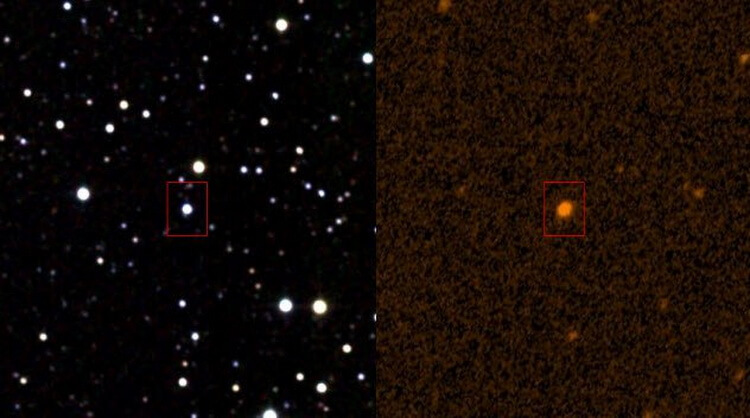
Around the star, Tabby, or KIC 8462852, sparked a lot of debate on the topic of the likelihood of having near it some “alien mega structure”. Located at a distance of about 1500 light years from Earth, this star was first discovered by the astronomer of Yale University Tabetai Boyajian and immediately attracted the attention of scientists with its unusual behavior. The brightness of the star changes from time to time so much so that this phenomenon cannot be explained by conventional presence in the region exoplanets. Therefore, among others, assumptions that attempt to explain this phenomenon, of course, there is also a version with aliens.
Supposedly sverhrazdutaya extraterrestrial civilization could build around the star Tabi special device that collects the energy and converts it into something more useful. When a star loses energy, it shimmers. So the idea of an extraterrestrial space alien megastructure is under a certain amount of sense.
However, it is still fresh and most likely theory that attempts to explain the extremely unusual behavior of stars Tabi, is the assumption that it eats one of their exoplanets. Sounds no less interesting, admittedly. However, the idea of aliens is not yet finally discarded.
Ganymede
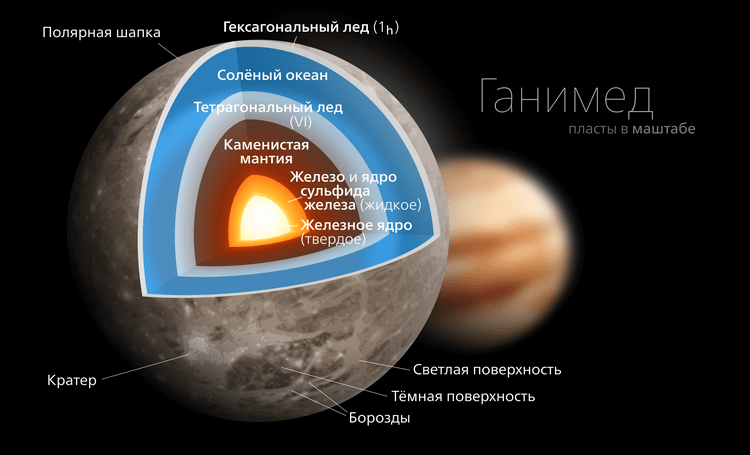
Another of Jupiter’s moons on which life can be. Like other moons, Ganymede is suspected subsurface ocean. And in such volume that the water it may contain even more than on Earth. Interestingly, the observation of the surface of Ganymede revealed the presence of indications that once it was flowing liquid water that seeped through cracks in the icy crust of the satellite.
The study of this satellite even led to the development of a new scientific method of research. For example, in the analysis of magnetic fields, scientists have discovered that this information can bring some insight about the internal structure of the satellite, including data on the presence beneath the surface of liquid water.
At the moment, Ganymede does not explore any single spacecraft. However, in 2022 it is planned to send him to the Jupiter Icy Moon Explorer, or simply JUICE, is an interplanetary Autonomous station, which, reaching Jupiter by 2030, will study his system.
10 places in the Universe where we are likely to find life
Nikolai Khizhnyak